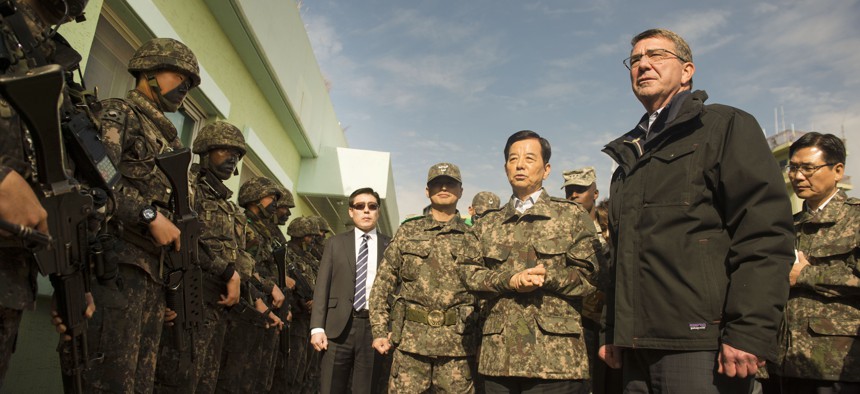
U.S. Defense Secretary Ash Carter and South Korean Defense Minister Minkoo Han visit the Demilitarized Zone, Nov.1, 2015. Photo by Senior Master Sgt. Adrian Cadiz
Maintaining the Edge in the Age of Everything
Ash Carter's message to the Defense One Summit: a new commitment to military, academic, business and scientific partnerships.
Today I am in Malaysia, working with our partners throughout the Asia-Pacific region to build a shared regional architecture that is strong enough, capable enough, and connected enough to ensure that all Asia-Pacific peoples and nations have the opportunity to rise, to prosper, and to determine their own destiny.
The Asia-Pacific is a region of both extraordinary opportunity and extraordinary challenges, including continuing provocation from North Korea, ongoing threats of terrorism, the growing impact of climate change, and challenges to the long-held universal principle of freedom of navigation.
It is a region which exemplifies the challenges of “the age of everything,” as threats become more transnational, more transregional, and cannot be addressed in isolation. It is an age that brings complex challenges in every part of the world, from the destabilizing and malign influence of Russian aggression in Ukraine and Syria, to the steady metastasis of the Islamic State in the Middle East, to the growing threat of cyber warfare.
Responding to these challenges requires a new set of tools and a new way of thinking. It requires those of us in the Department of Defense to think outside of our five-sided box and build on our history of innovative collaboration with the private sector community, a collaboration which in the past has benefitted not just our security, but our entire society, helping to create in its time the Internet, GPS, and in an earlier era, satellite communications and the jet engine.
As I meet with my counterparts in Kuala Lumpur, Deputy Secretary of Defense Bob Work and Army Chief of Staff Gen. Mark Milley, will be speaking at the Defense One Summit in Washington, D.C. I strongly support the messages they will deliver. And I believe that such conferences can help drill tunnels through the walls that sometimes seem to separate the government from private sector technologists, civilian leaders, and business and academic experts.
It was a cross-section of military, academic, and private sector experts who paved the way for the technology we are bringing forward to the Asia-Pacific, such as the latest Virginia-class submarines, the Navy's P-8 Poseidon surveillance aircraft, the newest stealth destroyer, the Zumwalt, and brand-new carrier-based E-2D Hawkeye early-warning-and-control aircraft. And to meet the future challenges of the Asia-Pacific and around the world, we’re investing in technologies such as new unmanned systems for the air and sea, a new long-range bomber, and new technologies like the electromagnetic railgun.
Achieving these breakthroughs requires us to build and rebuild the bridges between the technology community and the government to deliver the new and innovative designs I’ve made the hallmark of my commitment to the future of America’s military. When I began my career, most technology of consequence originated in the United States and much of it was sponsored by the government, especially in the Department of Defense. Today, much more of our technology is commercial and the technology base is global. And other countries have been trying to catch up to the latest breakthroughs that for the last several decades made our military more advanced than any other.
Technology once long possessed by only the most formidable militaries have now gotten into the hands of previously less-capable forces, and even non-state actors. Nations like China and Russia are also rapidly modernizing their militaries. At the same time, our reliance on satellites and the Internet has led to real vulnerabilities our adversaries are eager to exploit.
So to stay ahead of those challenges and stay the best, we’re investing aggressively in innovation. We’re pushing the envelope with research into both new technologies and innovative ways to apply them. And whether it’s robotics, data science, cyber defense, biotech, or hypersonic engines that can fly over five times the speed of sound, private sector innovation and partnerships will be critical to our future.
We’re also working with the private sector to help build the force of the future to attract and compete for the best talent from a new generation. We have an all-volunteer force. So for us to keep recruiting and retaining the best, the military has to continue to be recognized for what it is: the most rewarding and honorable place a young person can work and serve.
And because attracting the best and staying the best means that wherever possible, we must open ourselves to the talents and strengths of all Americans who can contribute with excellence to our force. As I’ve said before, everyone who is able and willing to serve and can meet the standards we require should have the full opportunity to do so.
So while I’m meeting with our Asia-Pacific partners in Malaysia to strengthen the bonds between our nations, it is my hope that the meetings and discussions taking place among industry and government leaders in Washington will continue to strengthen the bonds between sectors. In the age of everything, we need all of the talents and capabilities of the business, academic, and scientific worlds to help build the force of the future, strengthen our technical capabilities, and secure a peaceful future throughout the world.
NEXT STORY: How ISIS Spread in the Middle East



